Accounting Report: RTXM Stakeholder Analysis and Strategic Planning
VerifiedAdded on 2020/03/04
|10
|1994
|142
Report
AI Summary
This accounting report analyzes the RTXM clothing company's performance and strategic considerations. It begins with a stakeholder analysis, identifying key groups like customers, suppliers, and investors, and their respective information needs. The report then explores the balanced scorecard framework, assessing financial, customer, internal business processes, and innovation/learning perspectives for performance measurement. It evaluates supplier selection between Green Fashion and Super Cheap, considering corporate social responsibility and sustainability. Furthermore, the report analyzes the product life cycle of trousers/jeans, emphasizing environmental and social impacts. Finally, it addresses maximizing shareholder value, discussing strategic initiatives and the importance of aligning business strategies with investor objectives, using David Jones as a case study for shareholder return.
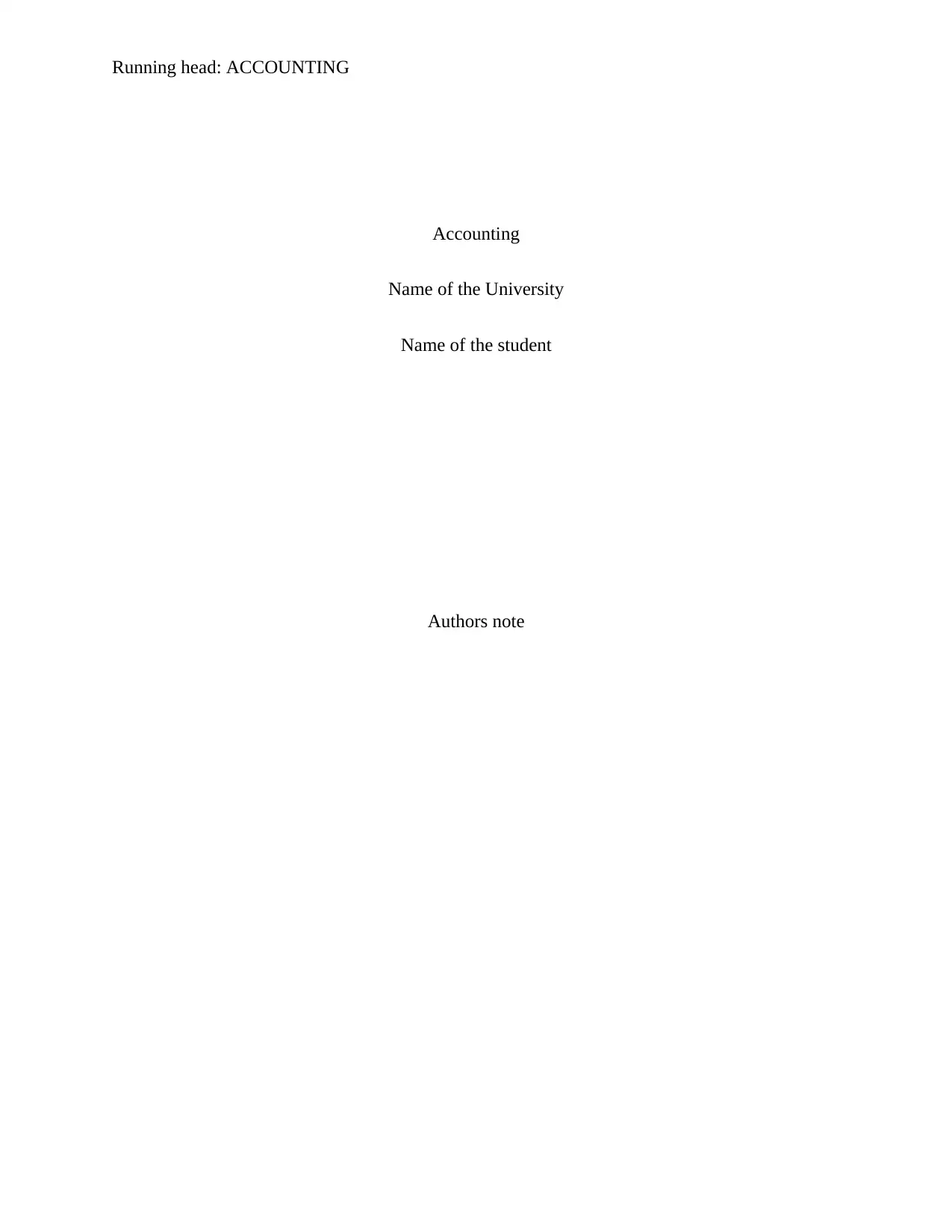
Running head: ACCOUNTING
Accounting
Name of the University
Name of the student
Authors note
Accounting
Name of the University
Name of the student
Authors note
Paraphrase This Document
Need a fresh take? Get an instant paraphrase of this document with our AI Paraphraser
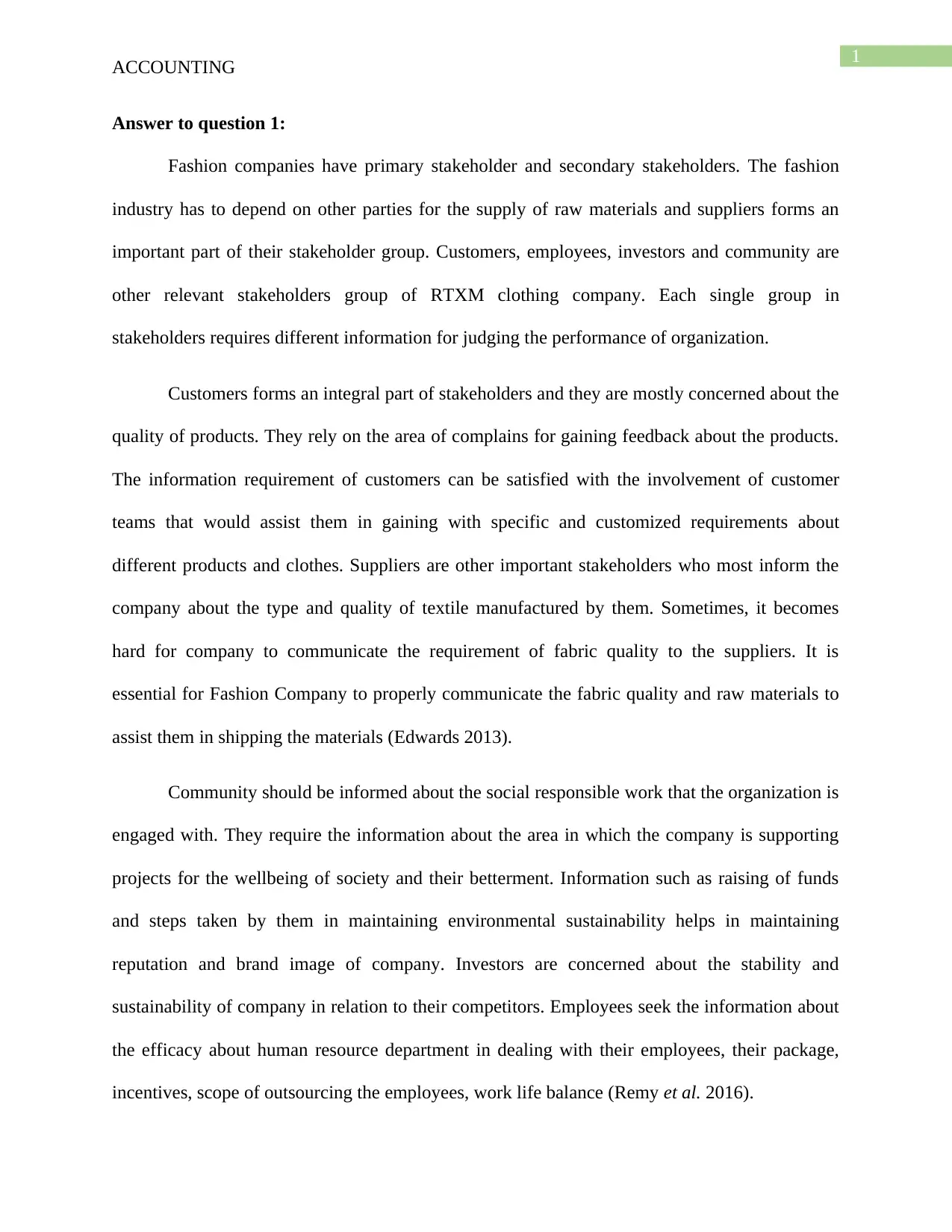
1
ACCOUNTING
Answer to question 1:
Fashion companies have primary stakeholder and secondary stakeholders. The fashion
industry has to depend on other parties for the supply of raw materials and suppliers forms an
important part of their stakeholder group. Customers, employees, investors and community are
other relevant stakeholders group of RTXM clothing company. Each single group in
stakeholders requires different information for judging the performance of organization.
Customers forms an integral part of stakeholders and they are mostly concerned about the
quality of products. They rely on the area of complains for gaining feedback about the products.
The information requirement of customers can be satisfied with the involvement of customer
teams that would assist them in gaining with specific and customized requirements about
different products and clothes. Suppliers are other important stakeholders who most inform the
company about the type and quality of textile manufactured by them. Sometimes, it becomes
hard for company to communicate the requirement of fabric quality to the suppliers. It is
essential for Fashion Company to properly communicate the fabric quality and raw materials to
assist them in shipping the materials (Edwards 2013).
Community should be informed about the social responsible work that the organization is
engaged with. They require the information about the area in which the company is supporting
projects for the wellbeing of society and their betterment. Information such as raising of funds
and steps taken by them in maintaining environmental sustainability helps in maintaining
reputation and brand image of company. Investors are concerned about the stability and
sustainability of company in relation to their competitors. Employees seek the information about
the efficacy about human resource department in dealing with their employees, their package,
incentives, scope of outsourcing the employees, work life balance (Remy et al. 2016).
ACCOUNTING
Answer to question 1:
Fashion companies have primary stakeholder and secondary stakeholders. The fashion
industry has to depend on other parties for the supply of raw materials and suppliers forms an
important part of their stakeholder group. Customers, employees, investors and community are
other relevant stakeholders group of RTXM clothing company. Each single group in
stakeholders requires different information for judging the performance of organization.
Customers forms an integral part of stakeholders and they are mostly concerned about the
quality of products. They rely on the area of complains for gaining feedback about the products.
The information requirement of customers can be satisfied with the involvement of customer
teams that would assist them in gaining with specific and customized requirements about
different products and clothes. Suppliers are other important stakeholders who most inform the
company about the type and quality of textile manufactured by them. Sometimes, it becomes
hard for company to communicate the requirement of fabric quality to the suppliers. It is
essential for Fashion Company to properly communicate the fabric quality and raw materials to
assist them in shipping the materials (Edwards 2013).
Community should be informed about the social responsible work that the organization is
engaged with. They require the information about the area in which the company is supporting
projects for the wellbeing of society and their betterment. Information such as raising of funds
and steps taken by them in maintaining environmental sustainability helps in maintaining
reputation and brand image of company. Investors are concerned about the stability and
sustainability of company in relation to their competitors. Employees seek the information about
the efficacy about human resource department in dealing with their employees, their package,
incentives, scope of outsourcing the employees, work life balance (Remy et al. 2016).
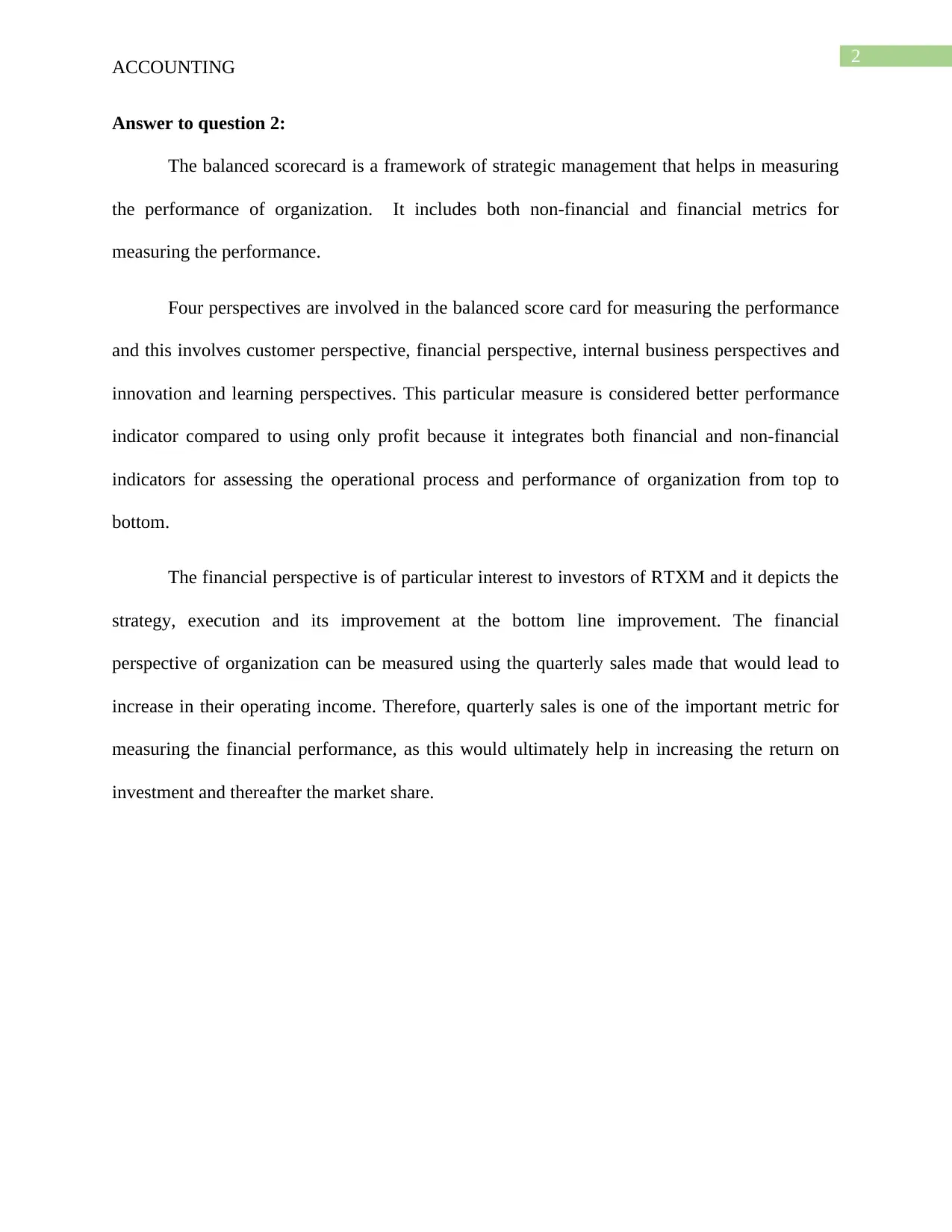
2
ACCOUNTING
Answer to question 2:
The balanced scorecard is a framework of strategic management that helps in measuring
the performance of organization. It includes both non-financial and financial metrics for
measuring the performance.
Four perspectives are involved in the balanced score card for measuring the performance
and this involves customer perspective, financial perspective, internal business perspectives and
innovation and learning perspectives. This particular measure is considered better performance
indicator compared to using only profit because it integrates both financial and non-financial
indicators for assessing the operational process and performance of organization from top to
bottom.
The financial perspective is of particular interest to investors of RTXM and it depicts the
strategy, execution and its improvement at the bottom line improvement. The financial
perspective of organization can be measured using the quarterly sales made that would lead to
increase in their operating income. Therefore, quarterly sales is one of the important metric for
measuring the financial performance, as this would ultimately help in increasing the return on
investment and thereafter the market share.
ACCOUNTING
Answer to question 2:
The balanced scorecard is a framework of strategic management that helps in measuring
the performance of organization. It includes both non-financial and financial metrics for
measuring the performance.
Four perspectives are involved in the balanced score card for measuring the performance
and this involves customer perspective, financial perspective, internal business perspectives and
innovation and learning perspectives. This particular measure is considered better performance
indicator compared to using only profit because it integrates both financial and non-financial
indicators for assessing the operational process and performance of organization from top to
bottom.
The financial perspective is of particular interest to investors of RTXM and it depicts the
strategy, execution and its improvement at the bottom line improvement. The financial
perspective of organization can be measured using the quarterly sales made that would lead to
increase in their operating income. Therefore, quarterly sales is one of the important metric for
measuring the financial performance, as this would ultimately help in increasing the return on
investment and thereafter the market share.
⊘ This is a preview!⊘
Do you want full access?
Subscribe today to unlock all pages.

Trusted by 1+ million students worldwide
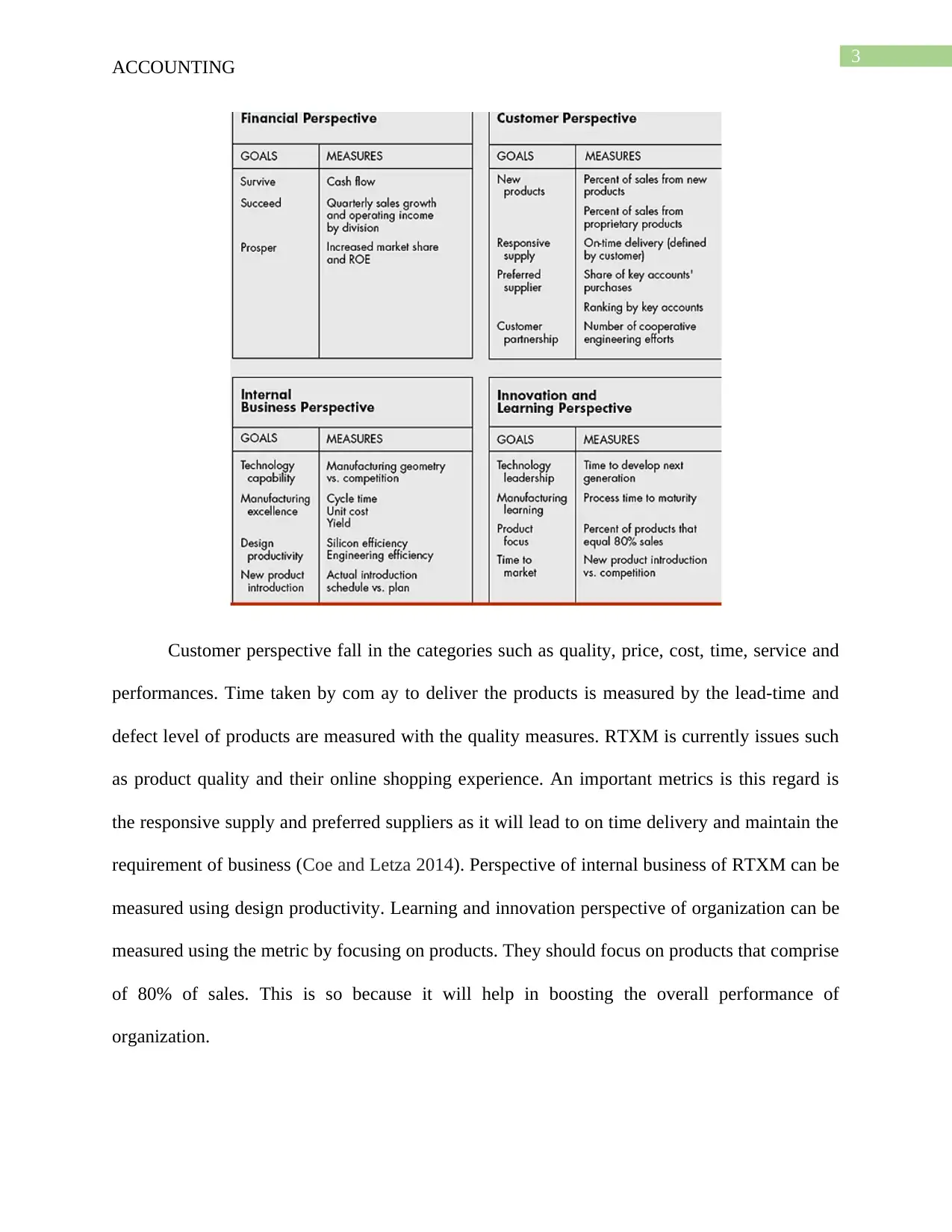
3
ACCOUNTING
Customer perspective fall in the categories such as quality, price, cost, time, service and
performances. Time taken by com ay to deliver the products is measured by the lead-time and
defect level of products are measured with the quality measures. RTXM is currently issues such
as product quality and their online shopping experience. An important metrics is this regard is
the responsive supply and preferred suppliers as it will lead to on time delivery and maintain the
requirement of business (Coe and Letza 2014). Perspective of internal business of RTXM can be
measured using design productivity. Learning and innovation perspective of organization can be
measured using the metric by focusing on products. They should focus on products that comprise
of 80% of sales. This is so because it will help in boosting the overall performance of
organization.
ACCOUNTING
Customer perspective fall in the categories such as quality, price, cost, time, service and
performances. Time taken by com ay to deliver the products is measured by the lead-time and
defect level of products are measured with the quality measures. RTXM is currently issues such
as product quality and their online shopping experience. An important metrics is this regard is
the responsive supply and preferred suppliers as it will lead to on time delivery and maintain the
requirement of business (Coe and Letza 2014). Perspective of internal business of RTXM can be
measured using design productivity. Learning and innovation perspective of organization can be
measured using the metric by focusing on products. They should focus on products that comprise
of 80% of sales. This is so because it will help in boosting the overall performance of
organization.
Paraphrase This Document
Need a fresh take? Get an instant paraphrase of this document with our AI Paraphraser
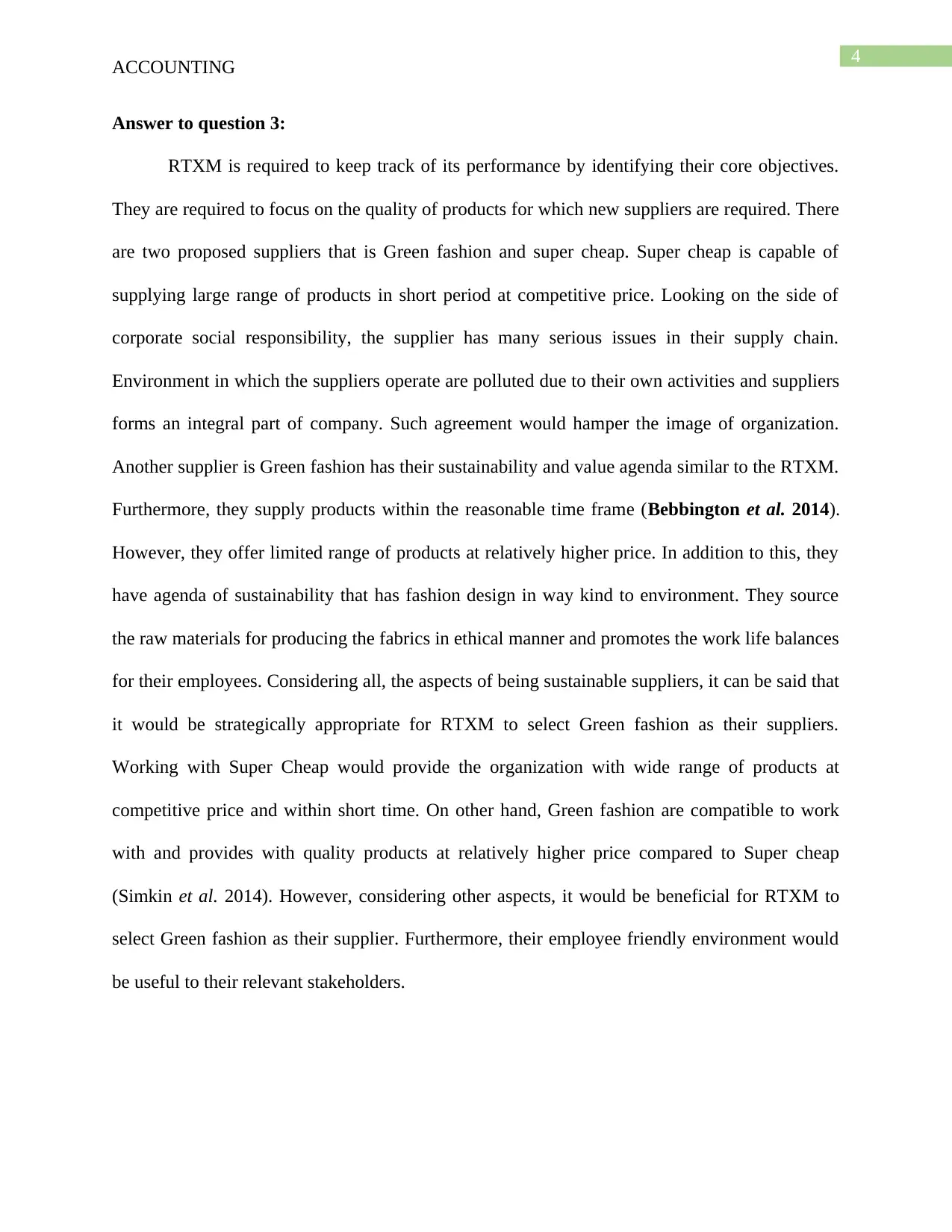
4
ACCOUNTING
Answer to question 3:
RTXM is required to keep track of its performance by identifying their core objectives.
They are required to focus on the quality of products for which new suppliers are required. There
are two proposed suppliers that is Green fashion and super cheap. Super cheap is capable of
supplying large range of products in short period at competitive price. Looking on the side of
corporate social responsibility, the supplier has many serious issues in their supply chain.
Environment in which the suppliers operate are polluted due to their own activities and suppliers
forms an integral part of company. Such agreement would hamper the image of organization.
Another supplier is Green fashion has their sustainability and value agenda similar to the RTXM.
Furthermore, they supply products within the reasonable time frame (Bebbington et al. 2014).
However, they offer limited range of products at relatively higher price. In addition to this, they
have agenda of sustainability that has fashion design in way kind to environment. They source
the raw materials for producing the fabrics in ethical manner and promotes the work life balances
for their employees. Considering all, the aspects of being sustainable suppliers, it can be said that
it would be strategically appropriate for RTXM to select Green fashion as their suppliers.
Working with Super Cheap would provide the organization with wide range of products at
competitive price and within short time. On other hand, Green fashion are compatible to work
with and provides with quality products at relatively higher price compared to Super cheap
(Simkin et al. 2014). However, considering other aspects, it would be beneficial for RTXM to
select Green fashion as their supplier. Furthermore, their employee friendly environment would
be useful to their relevant stakeholders.
ACCOUNTING
Answer to question 3:
RTXM is required to keep track of its performance by identifying their core objectives.
They are required to focus on the quality of products for which new suppliers are required. There
are two proposed suppliers that is Green fashion and super cheap. Super cheap is capable of
supplying large range of products in short period at competitive price. Looking on the side of
corporate social responsibility, the supplier has many serious issues in their supply chain.
Environment in which the suppliers operate are polluted due to their own activities and suppliers
forms an integral part of company. Such agreement would hamper the image of organization.
Another supplier is Green fashion has their sustainability and value agenda similar to the RTXM.
Furthermore, they supply products within the reasonable time frame (Bebbington et al. 2014).
However, they offer limited range of products at relatively higher price. In addition to this, they
have agenda of sustainability that has fashion design in way kind to environment. They source
the raw materials for producing the fabrics in ethical manner and promotes the work life balances
for their employees. Considering all, the aspects of being sustainable suppliers, it can be said that
it would be strategically appropriate for RTXM to select Green fashion as their suppliers.
Working with Super Cheap would provide the organization with wide range of products at
competitive price and within short time. On other hand, Green fashion are compatible to work
with and provides with quality products at relatively higher price compared to Super cheap
(Simkin et al. 2014). However, considering other aspects, it would be beneficial for RTXM to
select Green fashion as their supplier. Furthermore, their employee friendly environment would
be useful to their relevant stakeholders.
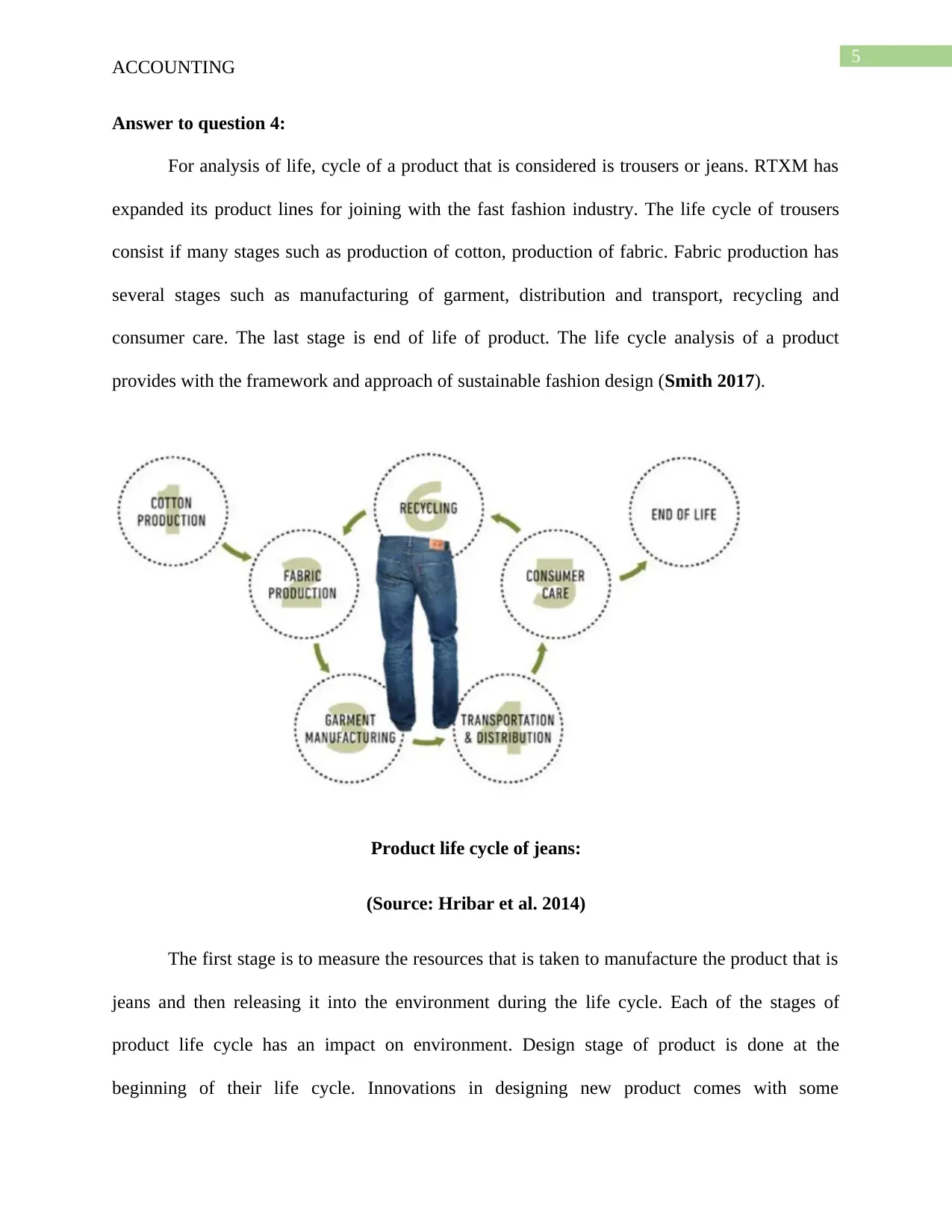
5
ACCOUNTING
Answer to question 4:
For analysis of life, cycle of a product that is considered is trousers or jeans. RTXM has
expanded its product lines for joining with the fast fashion industry. The life cycle of trousers
consist if many stages such as production of cotton, production of fabric. Fabric production has
several stages such as manufacturing of garment, distribution and transport, recycling and
consumer care. The last stage is end of life of product. The life cycle analysis of a product
provides with the framework and approach of sustainable fashion design (Smith 2017).
Product life cycle of jeans:
(Source: Hribar et al. 2014)
The first stage is to measure the resources that is taken to manufacture the product that is
jeans and then releasing it into the environment during the life cycle. Each of the stages of
product life cycle has an impact on environment. Design stage of product is done at the
beginning of their life cycle. Innovations in designing new product comes with some
ACCOUNTING
Answer to question 4:
For analysis of life, cycle of a product that is considered is trousers or jeans. RTXM has
expanded its product lines for joining with the fast fashion industry. The life cycle of trousers
consist if many stages such as production of cotton, production of fabric. Fabric production has
several stages such as manufacturing of garment, distribution and transport, recycling and
consumer care. The last stage is end of life of product. The life cycle analysis of a product
provides with the framework and approach of sustainable fashion design (Smith 2017).
Product life cycle of jeans:
(Source: Hribar et al. 2014)
The first stage is to measure the resources that is taken to manufacture the product that is
jeans and then releasing it into the environment during the life cycle. Each of the stages of
product life cycle has an impact on environment. Design stage of product is done at the
beginning of their life cycle. Innovations in designing new product comes with some
⊘ This is a preview!⊘
Do you want full access?
Subscribe today to unlock all pages.

Trusted by 1+ million students worldwide
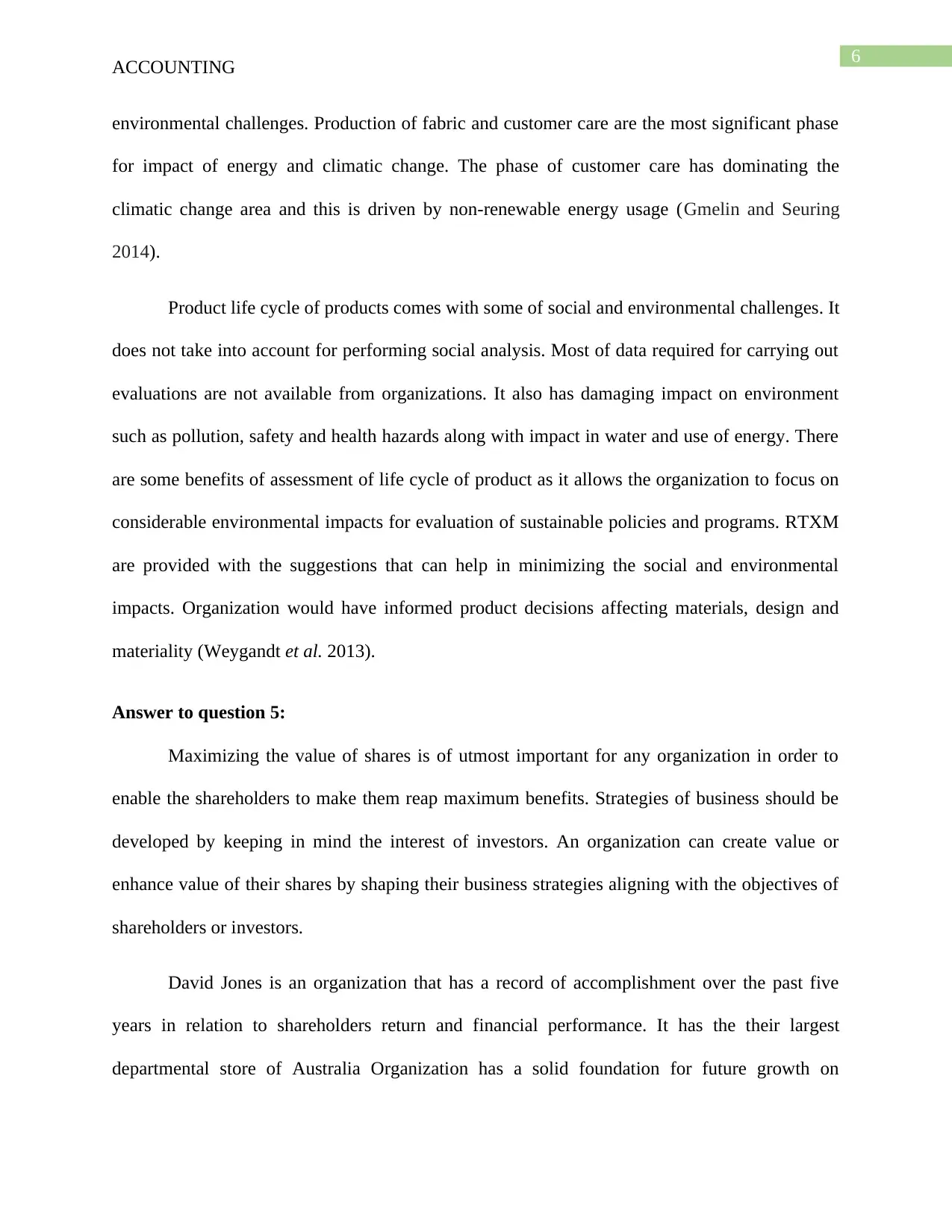
6
ACCOUNTING
environmental challenges. Production of fabric and customer care are the most significant phase
for impact of energy and climatic change. The phase of customer care has dominating the
climatic change area and this is driven by non-renewable energy usage (Gmelin and Seuring
2014).
Product life cycle of products comes with some of social and environmental challenges. It
does not take into account for performing social analysis. Most of data required for carrying out
evaluations are not available from organizations. It also has damaging impact on environment
such as pollution, safety and health hazards along with impact in water and use of energy. There
are some benefits of assessment of life cycle of product as it allows the organization to focus on
considerable environmental impacts for evaluation of sustainable policies and programs. RTXM
are provided with the suggestions that can help in minimizing the social and environmental
impacts. Organization would have informed product decisions affecting materials, design and
materiality (Weygandt et al. 2013).
Answer to question 5:
Maximizing the value of shares is of utmost important for any organization in order to
enable the shareholders to make them reap maximum benefits. Strategies of business should be
developed by keeping in mind the interest of investors. An organization can create value or
enhance value of their shares by shaping their business strategies aligning with the objectives of
shareholders or investors.
David Jones is an organization that has a record of accomplishment over the past five
years in relation to shareholders return and financial performance. It has the their largest
departmental store of Australia Organization has a solid foundation for future growth on
ACCOUNTING
environmental challenges. Production of fabric and customer care are the most significant phase
for impact of energy and climatic change. The phase of customer care has dominating the
climatic change area and this is driven by non-renewable energy usage (Gmelin and Seuring
2014).
Product life cycle of products comes with some of social and environmental challenges. It
does not take into account for performing social analysis. Most of data required for carrying out
evaluations are not available from organizations. It also has damaging impact on environment
such as pollution, safety and health hazards along with impact in water and use of energy. There
are some benefits of assessment of life cycle of product as it allows the organization to focus on
considerable environmental impacts for evaluation of sustainable policies and programs. RTXM
are provided with the suggestions that can help in minimizing the social and environmental
impacts. Organization would have informed product decisions affecting materials, design and
materiality (Weygandt et al. 2013).
Answer to question 5:
Maximizing the value of shares is of utmost important for any organization in order to
enable the shareholders to make them reap maximum benefits. Strategies of business should be
developed by keeping in mind the interest of investors. An organization can create value or
enhance value of their shares by shaping their business strategies aligning with the objectives of
shareholders or investors.
David Jones is an organization that has a record of accomplishment over the past five
years in relation to shareholders return and financial performance. It has the their largest
departmental store of Australia Organization has a solid foundation for future growth on
Paraphrase This Document
Need a fresh take? Get an instant paraphrase of this document with our AI Paraphraser
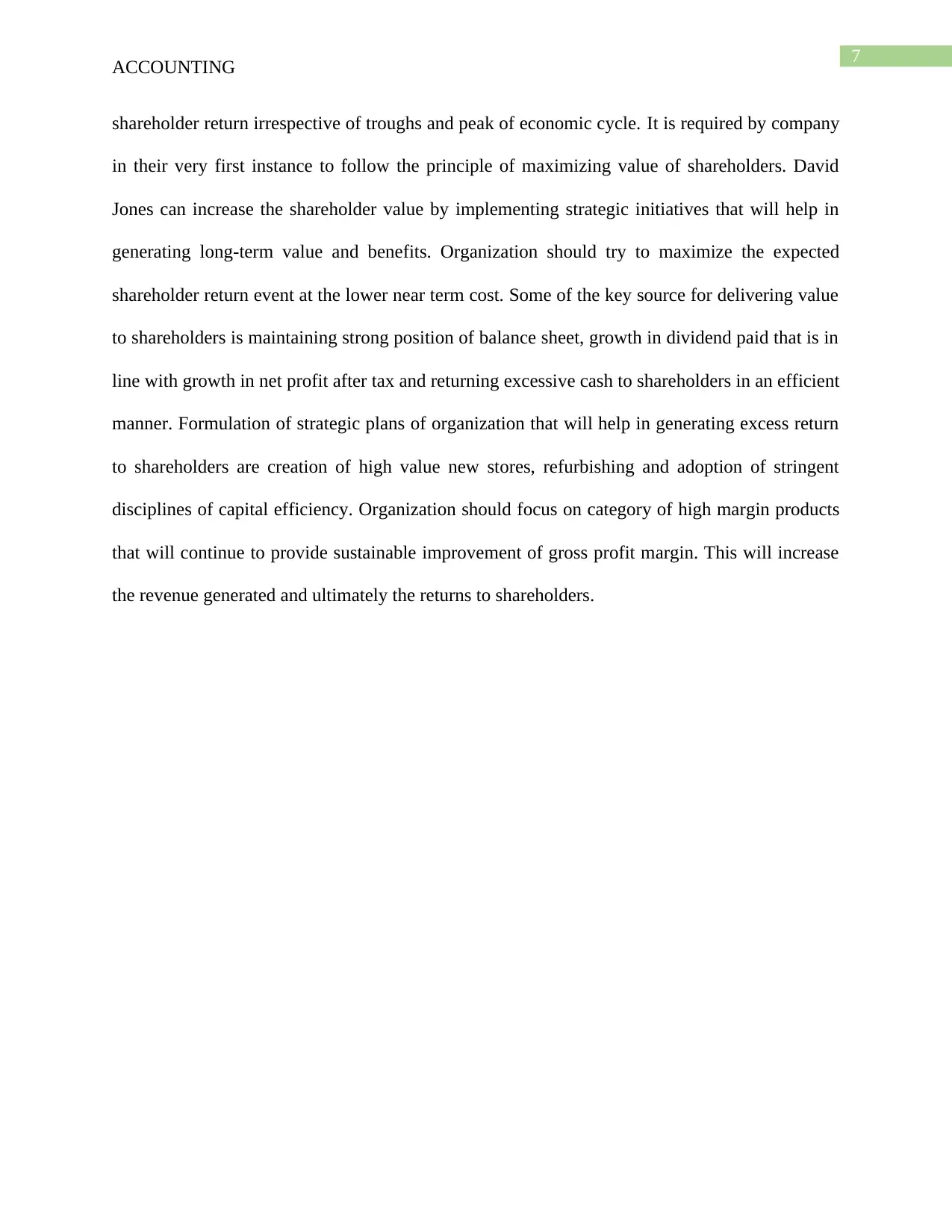
7
ACCOUNTING
shareholder return irrespective of troughs and peak of economic cycle. It is required by company
in their very first instance to follow the principle of maximizing value of shareholders. David
Jones can increase the shareholder value by implementing strategic initiatives that will help in
generating long-term value and benefits. Organization should try to maximize the expected
shareholder return event at the lower near term cost. Some of the key source for delivering value
to shareholders is maintaining strong position of balance sheet, growth in dividend paid that is in
line with growth in net profit after tax and returning excessive cash to shareholders in an efficient
manner. Formulation of strategic plans of organization that will help in generating excess return
to shareholders are creation of high value new stores, refurbishing and adoption of stringent
disciplines of capital efficiency. Organization should focus on category of high margin products
that will continue to provide sustainable improvement of gross profit margin. This will increase
the revenue generated and ultimately the returns to shareholders.
ACCOUNTING
shareholder return irrespective of troughs and peak of economic cycle. It is required by company
in their very first instance to follow the principle of maximizing value of shareholders. David
Jones can increase the shareholder value by implementing strategic initiatives that will help in
generating long-term value and benefits. Organization should try to maximize the expected
shareholder return event at the lower near term cost. Some of the key source for delivering value
to shareholders is maintaining strong position of balance sheet, growth in dividend paid that is in
line with growth in net profit after tax and returning excessive cash to shareholders in an efficient
manner. Formulation of strategic plans of organization that will help in generating excess return
to shareholders are creation of high value new stores, refurbishing and adoption of stringent
disciplines of capital efficiency. Organization should focus on category of high margin products
that will continue to provide sustainable improvement of gross profit margin. This will increase
the revenue generated and ultimately the returns to shareholders.
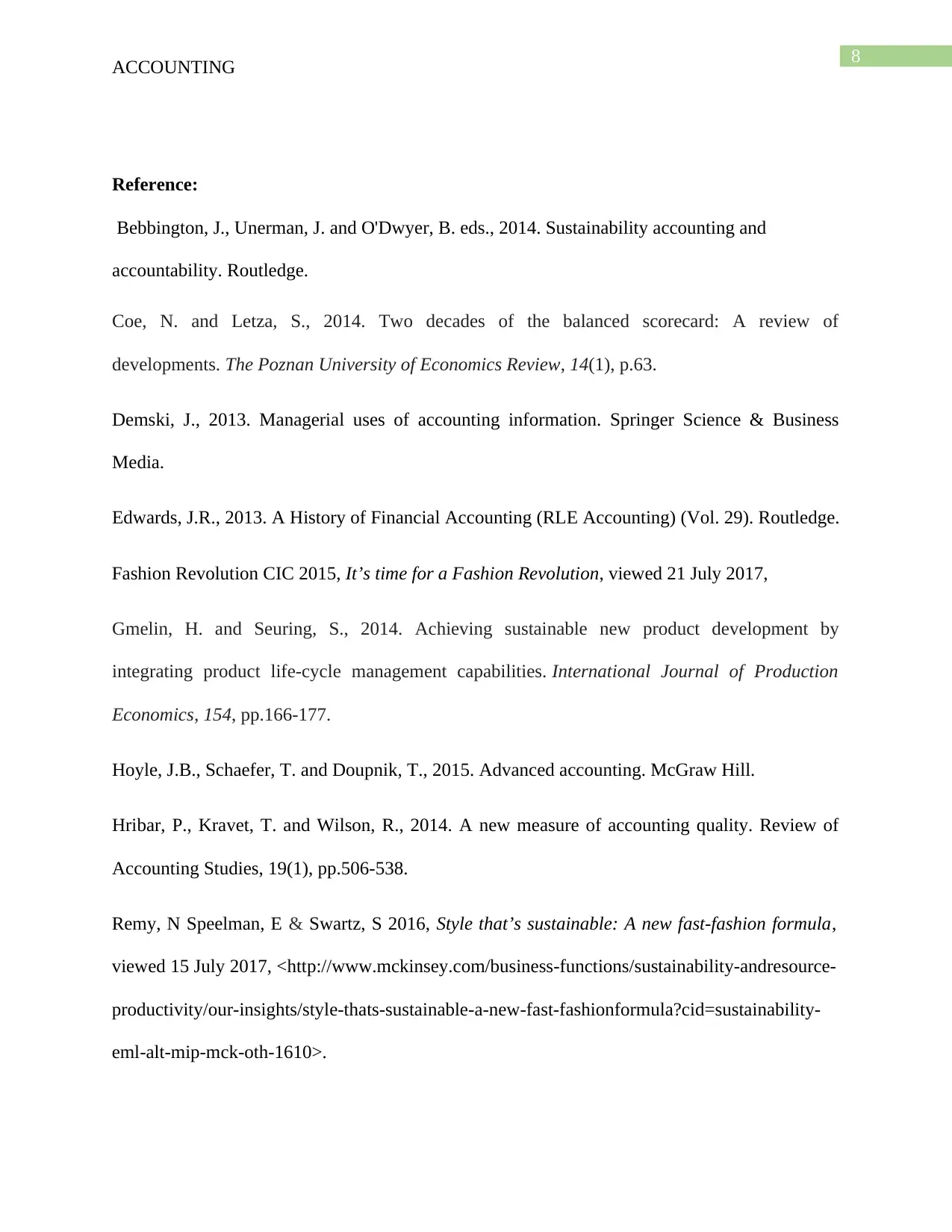
8
ACCOUNTING
Reference:
Bebbington, J., Unerman, J. and O'Dwyer, B. eds., 2014. Sustainability accounting and
accountability. Routledge.
Coe, N. and Letza, S., 2014. Two decades of the balanced scorecard: A review of
developments. The Poznan University of Economics Review, 14(1), p.63.
Demski, J., 2013. Managerial uses of accounting information. Springer Science & Business
Media.
Edwards, J.R., 2013. A History of Financial Accounting (RLE Accounting) (Vol. 29). Routledge.
Fashion Revolution CIC 2015, It’s time for a Fashion Revolution, viewed 21 July 2017,
Gmelin, H. and Seuring, S., 2014. Achieving sustainable new product development by
integrating product life-cycle management capabilities. International Journal of Production
Economics, 154, pp.166-177.
Hoyle, J.B., Schaefer, T. and Doupnik, T., 2015. Advanced accounting. McGraw Hill.
Hribar, P., Kravet, T. and Wilson, R., 2014. A new measure of accounting quality. Review of
Accounting Studies, 19(1), pp.506-538.
Remy, N Speelman, E & Swartz, S 2016, Style that’s sustainable: A new fast-fashion formula,
viewed 15 July 2017, <http://www.mckinsey.com/business-functions/sustainability-andresource-
productivity/our-insights/style-thats-sustainable-a-new-fast-fashionformula?cid=sustainability-
eml-alt-mip-mck-oth-1610>.
ACCOUNTING
Reference:
Bebbington, J., Unerman, J. and O'Dwyer, B. eds., 2014. Sustainability accounting and
accountability. Routledge.
Coe, N. and Letza, S., 2014. Two decades of the balanced scorecard: A review of
developments. The Poznan University of Economics Review, 14(1), p.63.
Demski, J., 2013. Managerial uses of accounting information. Springer Science & Business
Media.
Edwards, J.R., 2013. A History of Financial Accounting (RLE Accounting) (Vol. 29). Routledge.
Fashion Revolution CIC 2015, It’s time for a Fashion Revolution, viewed 21 July 2017,
Gmelin, H. and Seuring, S., 2014. Achieving sustainable new product development by
integrating product life-cycle management capabilities. International Journal of Production
Economics, 154, pp.166-177.
Hoyle, J.B., Schaefer, T. and Doupnik, T., 2015. Advanced accounting. McGraw Hill.
Hribar, P., Kravet, T. and Wilson, R., 2014. A new measure of accounting quality. Review of
Accounting Studies, 19(1), pp.506-538.
Remy, N Speelman, E & Swartz, S 2016, Style that’s sustainable: A new fast-fashion formula,
viewed 15 July 2017, <http://www.mckinsey.com/business-functions/sustainability-andresource-
productivity/our-insights/style-thats-sustainable-a-new-fast-fashionformula?cid=sustainability-
eml-alt-mip-mck-oth-1610>.
⊘ This is a preview!⊘
Do you want full access?
Subscribe today to unlock all pages.

Trusted by 1+ million students worldwide
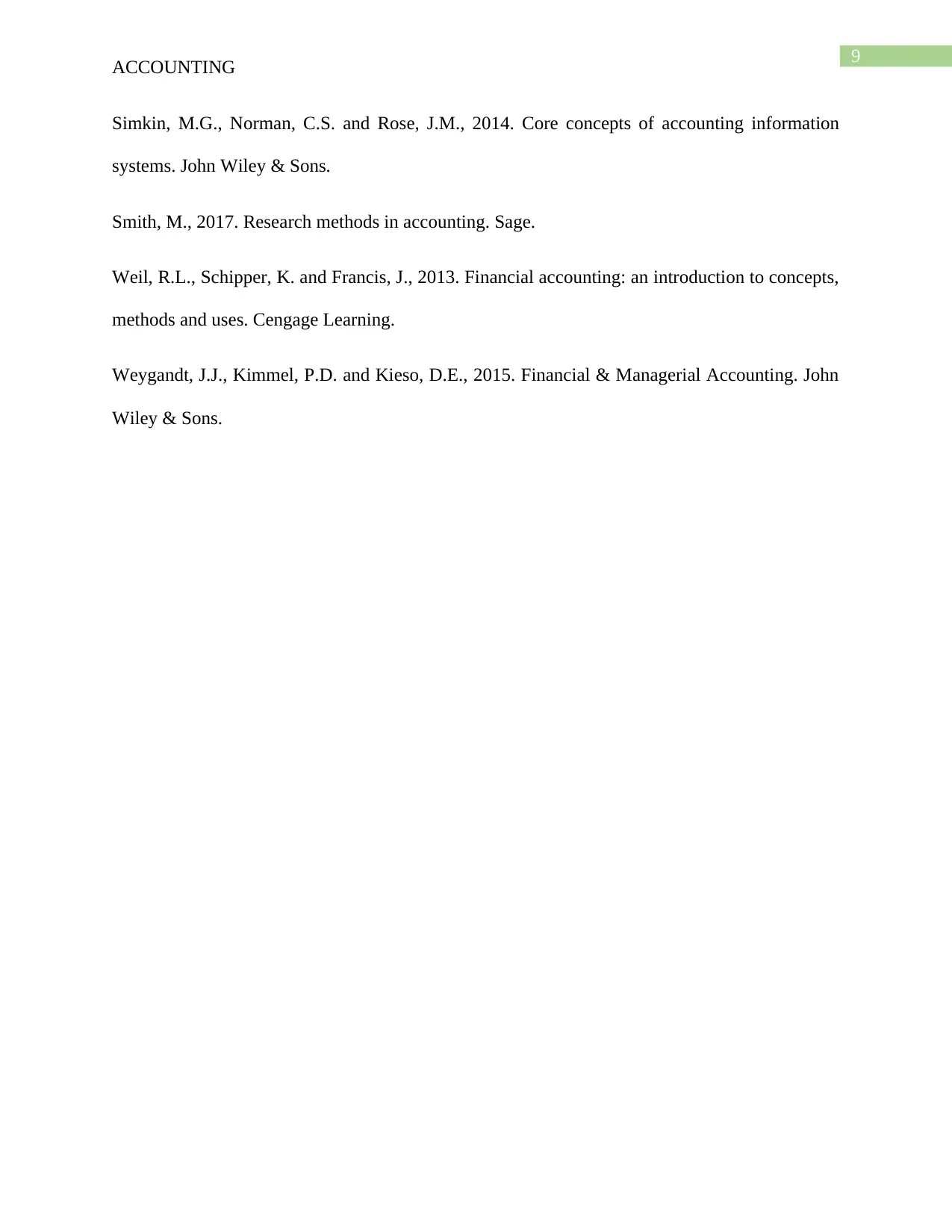
9
ACCOUNTING
Simkin, M.G., Norman, C.S. and Rose, J.M., 2014. Core concepts of accounting information
systems. John Wiley & Sons.
Smith, M., 2017. Research methods in accounting. Sage.
Weil, R.L., Schipper, K. and Francis, J., 2013. Financial accounting: an introduction to concepts,
methods and uses. Cengage Learning.
Weygandt, J.J., Kimmel, P.D. and Kieso, D.E., 2015. Financial & Managerial Accounting. John
Wiley & Sons.
ACCOUNTING
Simkin, M.G., Norman, C.S. and Rose, J.M., 2014. Core concepts of accounting information
systems. John Wiley & Sons.
Smith, M., 2017. Research methods in accounting. Sage.
Weil, R.L., Schipper, K. and Francis, J., 2013. Financial accounting: an introduction to concepts,
methods and uses. Cengage Learning.
Weygandt, J.J., Kimmel, P.D. and Kieso, D.E., 2015. Financial & Managerial Accounting. John
Wiley & Sons.
1 out of 10
Related Documents
Your All-in-One AI-Powered Toolkit for Academic Success.
+13062052269
info@desklib.com
Available 24*7 on WhatsApp / Email
![[object Object]](/_next/static/media/star-bottom.7253800d.svg)
Unlock your academic potential
Copyright © 2020–2025 A2Z Services. All Rights Reserved. Developed and managed by ZUCOL.





